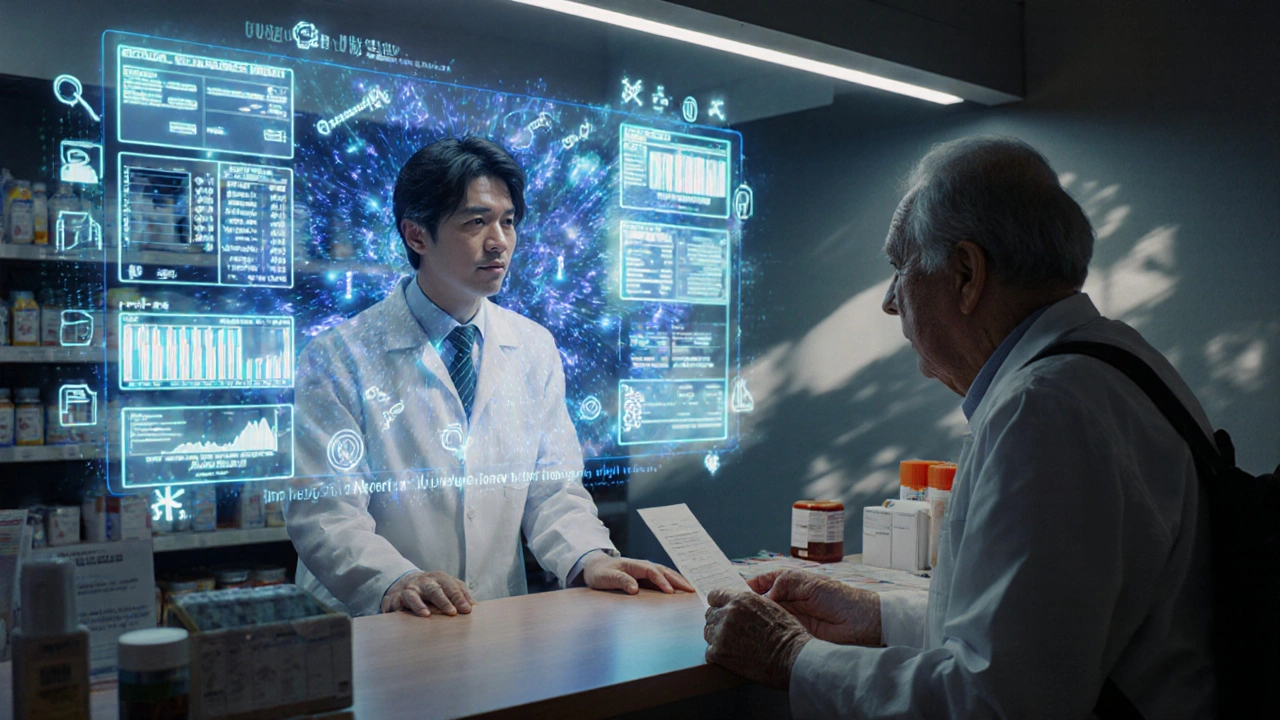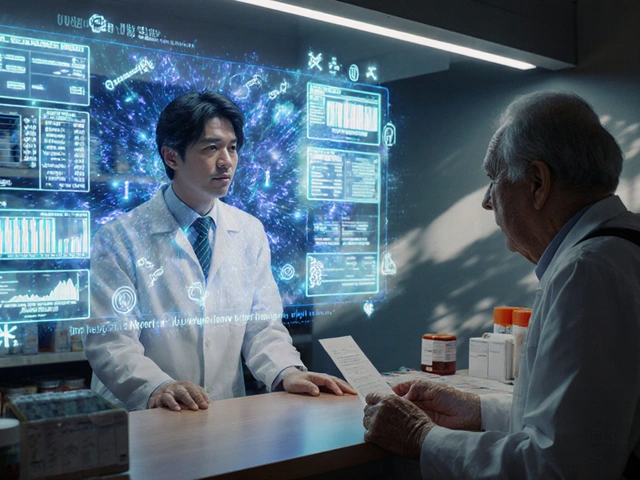Imagine this: You’re a pharmacist in Melbourne, and a patient walks in with a new prescription for warfarin. You check the script, notice the dose is high for someone their age, and remember they were recently discharged from hospital after a fall. But you don’t have access to their full medical record. No lab results. No recent vitals. No notes from their GP. You call the clinic. Wait 20 minutes. Get a vague answer. You dispense the script - but you’re uneasy. This isn’t rare. It happens every day.
Now imagine the same scenario, but your pharmacy system is connected to the patient’s EHR. You see the recent INR of 5.2. You see the discharge summary that says “hold anticoagulants until follow-up.” You see the note from the cardiologist: “consider reduced dose due to renal impairment.” You call the prescriber, not to ask for clarification, but to say: “I’ve flagged a potential risk. Can we adjust the dose to 2.5mg daily?” You’ve just prevented a bleed. That’s what EHR integration does - it turns pharmacists from order-fillers into active care partners.
How EHR Integration Actually Works Between Pharmacies and Providers
EHR integration isn’t magic. It’s a series of technical connections that let pharmacy systems talk to doctor’s systems. The backbone is two standards: NCPDP SCRIPT and HL7 FHIR. SCRIPT handles the actual prescription - who it’s for, what drug, how much, how often. FHIR does the heavy lifting: lab values, diagnoses, allergies, previous meds, care plans. Together, they let a pharmacist see the full picture - not just the scrip.
When a doctor writes a prescription in Epic or Cerner, it doesn’t just go to the pharmacy’s printer. It goes directly into the pharmacy’s management system - like PioneerRx or SmartClinix - and appears in the pharmacist’s queue. But here’s the game-changer: the pharmacist can then send information back. If they spot a drug interaction, they can flag it. If they adjust the dose, they can update the record. If they do a medication review, they can send a care plan back to the doctor’s EHR. This two-way street is called bidirectional integration. Only 15-20% of U.S. pharmacies have it right now. But it’s growing fast.
In Australia, the My Health Record system has shown similar results: a 27% drop in preventable hospitalizations when pharmacists had access to real-time patient data. That’s not theory. That’s real people avoiding ER visits because someone saw the full story.
The Real Benefits: Less Errors, Fewer Hospital Trips, More Time for Patients
Let’s cut through the jargon. What does this integration actually mean for patients and pharmacists?
- 48% fewer medication errors - automated alerts catch things humans miss, like a kidney patient on a nephrotoxic drug.
- 31% fewer hospital readmissions - when pharmacists can see recent lab work and adjust meds before things go south.
- 63% faster prescription processing - no more phone tag. No more waiting for prior authorizations. Electronic prior auths now take hours, not days.
- 4.2 medication problems solved per patient - pharmacists with EHR access catch way more issues than those without. Without integration, it’s 1.7 per visit.
One study found that integrated systems saved $1,250 per patient per year. That’s from avoiding ER visits, hospital stays, and wasted meds. And it’s not just about cost. It’s about dignity. A patient with diabetes, heart disease, and depression is on seven medications. Without integration, their pharmacist is guessing. With it, they’re a co-manager of their care.
And it’s not just the pharmacist. Doctors get alerts too. If a patient picks up a new antidepressant, the GP sees it. If the pharmacist changes the dose, the doctor gets notified. No more surprises at the next appointment.

Why Most Pharmacies Still Don’t Have It - And What’s Holding Them Back
So if it’s so good, why isn’t everyone using it?
The biggest barrier? Cost. For an independent pharmacy, setting up integration can cost between $15,000 and $50,000 upfront. Then $5,000-$15,000 a year to maintain. That’s more than most small pharmacies make in profit. Big chains like CVS or Walgreens? They’ve got teams and budgets. Independent pharmacies? They’re on their own.
Then there’s time. Pharmacists average just 2.1 minutes per patient interaction. Even if they have EHR access, they don’t have time to dig through it. One survey found 68% of pharmacists feel overwhelmed trying to review data during busy shifts. The system needs to be smart - not just connected. Alerts should be relevant. Data should be summarized. Not a 20-page PDF dumped into their screen.
And then there’s the mess of systems. There are over 120 different EHRs and 50 pharmacy systems in the U.S. They don’t all speak the same language. Even when they’re supposed to, data mapping fails. A lab value in one system might be called “creatinine” in another, or “Cr” or “Serum Creat.” Without standardization, integration breaks down. A 2023 report found 73% of health exchanges struggle to match pharmacy data to medical records.
Reimbursement is another silent killer. Only 19 U.S. states have payment models for pharmacists to get paid for EHR-based care coordination. In Australia, Medicare doesn’t pay pharmacists for reviewing EHR data - even though they’re the ones catching the errors. Until someone pays for this work, it’s seen as a nice-to-have, not a necessity.
Who’s Getting It Right - And What Tools Are Actually Used
Some players are leading the way. Surescripts handles 22 billion transactions a year. Their Medication History tool pulls in 3.5 billion annual prescription records. That’s how a pharmacist in Sydney can see if a patient filled a script in Brisbane last week. Their Electronic Prior Authorization system cuts approval time from days to hours.
SmartClinix and DocStation are pharmacy-specific platforms built for integration. SmartClinix starts at $199/month and connects to Epic and Cerner. Users praise the seamless flow but complain about the learning curve. DocStation is strong on billing and provider networks, but lacks features for specialty meds.
UpToDate integrates directly into EHRs, giving clinicians evidence-based drug info right where they’re writing the script. And in the U.S., the CommonWell Health Alliance connects 20,000 providers - but only 5% of pharmacies are on it. The gap is wide.
In Australia, the My Health Record system is slowly expanding. Pharmacists can now view medications, allergies, and immunizations - but access isn’t automatic. Patients have to opt in. And not all pharmacies are connected yet.

What’s Coming Next - And Why It Matters
The future is here, but it’s uneven. The Office of the National Coordinator for Health IT wants 50% of community pharmacies to have bidirectional EHR integration by 2027. CMS is pushing Medicare Part D plans to require it by 2025. California’s SB 1115 mandates it for medication therapy management by 2026.
And now, AI is stepping in. CVS and Walgreens are testing machine learning models that scan integrated EHR-pharmacy data to flag high-risk patients. One pilot showed a 37% improvement in spotting medication issues before they caused harm. That’s not sci-fi. That’s happening now.
But none of this will scale without payment. Dr. Lucinda Maine of the American Association of Colleges of Pharmacy put it bluntly: “Without sustainable payment models, EHR integration will remain a luxury.”
Right now, pharmacists are doing the work of care coordinators - but they’re not getting paid for it. If Medicare and private insurers start reimbursing for EHR-based medication reviews, adoption will explode. Until then, it’s a patchwork of early adopters and frustrated professionals.
What You Can Do - Even If You’re Not a Tech Expert
Whether you’re a pharmacist, a GP, or a patient, you can push for better integration:
- Ask your pharmacy: “Do you have access to my full EHR?” If they say no, ask why. Push for it.
- Check your My Health Record (in Australia): Is your medication list up to date? If not, ask your pharmacist to update it.
- Support policy changes: Advocate for state and federal reimbursement for pharmacist services tied to EHR access.
- Use your voice: If you’ve had a bad experience because your meds weren’t coordinated, tell your provider. Tell your local MP. This isn’t just a tech issue - it’s a safety issue.
Integration isn’t about fancy software. It’s about giving the right person the right information at the right time. The pharmacist at the counter knows your meds better than anyone. They just need to see the full story.
What is EHR integration in pharmacy?
EHR integration in pharmacy means connecting a pharmacy’s management system directly to a patient’s electronic health record used by doctors and hospitals. This allows pharmacists to see a patient’s full medical history - including diagnoses, lab results, allergies, and other medications - and send updates back, like dose changes or medication reviews. It turns the pharmacy from a prescription drop-off point into an active part of the care team.
Do all pharmacies have EHR integration?
No. Only about 15-20% of pharmacies in the U.S. have full bidirectional EHR integration. In Australia, adoption is growing through My Health Record, but it’s still inconsistent. Health system pharmacies (like those in hospitals or large chains) are far more likely to be connected than independent community pharmacies. Many independents can’t afford the cost or lack the technical support.
How does EHR integration reduce medication errors?
It gives pharmacists real-time access to critical data like kidney function, recent lab results, current medications, and allergy history. Automated alerts flag dangerous combinations - like a blood thinner and an NSAID - before the prescription is filled. Studies show integrated systems reduce medication errors by 48%. Without it, pharmacists are often working with incomplete information, making mistakes more likely.
Can patients access their own EHR data through the pharmacy?
Not directly - but they can influence it. In Australia, patients can view and update their My Health Record, including medications. They can ask their pharmacist to check and correct any inaccuracies. In the U.S., the CARIN Blue Button 2.0 system lets patients download their data from insurers and share it with pharmacies. Patient involvement is key to keeping records accurate.
Why don’t pharmacists use EHR data even when it’s available?
Time is the biggest barrier. Pharmacists average just 2.1 minutes per patient interaction. Even with EHR access, sifting through pages of data isn’t practical. Systems need to be smarter - showing only the most critical info upfront, with alerts that are clear and actionable. If the interface is clunky or the alerts are too noisy, pharmacists will ignore them.
Is EHR integration worth the cost for small pharmacies?
It depends. The upfront cost is $15,000-$50,000, with $5,000-$15,000 annually to maintain. For many small pharmacies, that’s not feasible. But the long-term benefits - fewer errors, fewer liability claims, better patient outcomes, and potential future reimbursement - can outweigh the cost. Some pharmacies join cooperatives or use vendor partnerships to share costs. Waiting means falling further behind as regulations and patient expectations rise.




Erika Lukacs
November 12, 2025 at 06:24It’s funny how we treat pharmacists like glorified cashiers when they’re the ones catching the errors no one else has time to see. We’ve outsourced our health literacy to them, then act surprised when they’re overwhelmed. It’s not a tech problem-it’s a cultural one.
Rebekah Kryger
November 12, 2025 at 19:52Let’s be real-EHR integration is just another corporate buzzword dressed up as patient care. You think a pharmacist in rural Kansas giving a 2-minute glance at a FHIR blob is gonna prevent a bleed? Nah. It’s just more data noise. And don’t get me started on NCPDP SCRIPT. Half the systems still send prescriptions as PDFs with handwritten notes.
Parv Trivedi
November 13, 2025 at 17:32I come from a small town in India where pharmacists often know patients by name, their kids, their allergies, even their coffee order. We don’t need fancy systems to save lives-we need trust and time. But I see the value in tech if it gives that time back. The real win isn’t the data-it’s letting the pharmacist be a human again.
Willie Randle
November 15, 2025 at 16:44There’s a fundamental misunderstanding here: EHR integration isn’t about convenience-it’s about accountability. When a pharmacist can document a dose adjustment and send it back to the EHR, they’re creating a legally defensible audit trail. That’s not just clinical-it’s regulatory. And yes, it’s expensive, but the cost of *not* doing it? Malpractice suits, readmissions, and lost trust. The math is clear.
Connor Moizer
November 16, 2025 at 11:33Y’all are overcomplicating this. If a pharmacist sees a patient’s INR is 5.2 and the doc didn’t flag it, they call the doc. End of story. You don’t need a $50k system for that. You need a phone and a damn minute. The real issue? Doctors don’t answer their phones. Fix that first.
kanishetti anusha
November 18, 2025 at 03:43I work in a pharmacy in Bangalore-we don’t have EHR integration, but we have something better: community. We call the doctors. We remember if Mrs. Rao’s husband passed last year and her BP meds changed. We write notes on sticky pads. Tech should help us, not replace the human connection. Maybe we don’t need more data-we need more time to use what we already have.
roy bradfield
November 18, 2025 at 05:52Let me tell you what’s really going on-this EHR integration push is just Big Pharma and health tech corporations siphoning government funds under the guise of ‘patient safety.’ Who benefits? The vendors. Who pays? The taxpayer. Who gets the time back? No one. Pharmacists are still running around like headless chickens. This isn’t progress-it’s a distraction. They’ll sell you a $200k ‘smart’ system that just pings you with 47 alerts a day for things you already know. And then they’ll charge you extra for ‘analytics.’
Patrick Merk
November 18, 2025 at 20:06My uncle’s a pharmacist in Cork. He told me about a guy who came in with three blood thinners and a new antifungal. Without integration, he’d’ve had to call three different clinics. With integration? He saw the whole picture in 90 seconds. He changed the dose, sent a note back, and the GP replied within an hour. That’s not magic. That’s dignity. We’re not talking about software-we’re talking about letting people live without fear of a pill killing them.
Liam Dunne
November 20, 2025 at 15:36One thing no one mentions: interoperability isn’t just technical-it’s political. Hospitals and EHR vendors lock data in like proprietary ecosystems. You can’t integrate if the systems are designed to compete, not collaborate. We need open APIs, not vendor lock-in. And yes, I’ve seen pharmacies pay $40k for a system that only talks to one EHR. That’s not innovation. That’s extortion.
Vera Wayne
November 22, 2025 at 07:52And yet… we still let patients opt out of My Health Record. Why? Because we think they won’t understand it. But if we don’t give them control, they’ll never trust it. I’ve had patients show me their own records, corrected by their pharmacist, and say, ‘This is the first time I’ve ever felt like I’m part of my own care.’ That’s not tech. That’s transformation.
Rodney Keats
November 23, 2025 at 13:42Wow. So pharmacists are now ‘active care partners’? Next they’ll be giving TED Talks and writing their own medical guidelines. Meanwhile, the guy who actually wrote the script is still waiting for a call back from a pharmacy that can’t even get their fax machine to work. This whole thing is a distraction. The real problem? Doctors who don’t know how to write a safe prescription. Fix that. Not the printer.